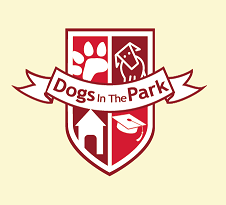I had a fairly frustrating meeting today. I met with someone who has a 9 month old dog and who kept insisting that her dog was a puppy. This is not an uncommon error, especially after the “puppy food for a full year till he is full grown” dog food ad from the 1980s. In this ad, a cute cartoon puppy came onto the screen and explained why a growing young dog needed puppy food until he was full grown. Many people think that their young dogs are puppies until they are fully grown because you feed puppy food until they are fully grown. A better term for puppy food, and one often used now in marketing is “growth formula”. Dogs need a different ratio of calcium to phosphorus while they are growing in order to lay down solid bone mass than they do as adults, so feeding a growth formula is important until the young dog stops growing. In large breed dogs this may happen at about one year of age, and in giant breed dogs, this may not happen until the dog is almost two. Never the less, these young dogs are NOT puppies.
Puppy is a general term for a young dog, but it is more accurate to use it the way we would use “infant”. If your son or daughter is 15, you would not refer to him or her as an infant! My great grandparents referred to their two children as “the babies” in my hearing when my grandmother and her brother were well into their seventies; this was a cultural thing I am sure, but no one would have mistaken these older adults as actual infants. Likewise, I have a number of students who refer to their dogs generically as “the pups” or “the puppies” even when they are much older dogs.
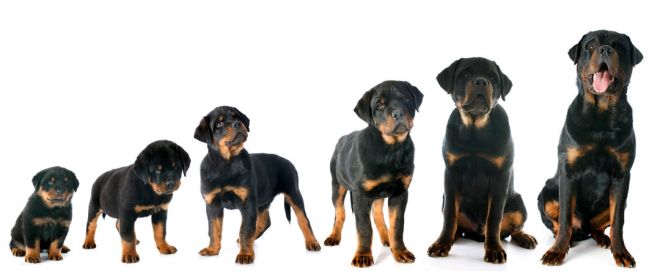
So, what is frustrating about having a young adult dog referred to as a puppy? As with so many things, it depends! If you are referring to your “pups” as in “the pups are with us today” I don’t have a problem. When you are excusing misbehaviour in an adult dog because he is “just a puppy” things unravel fairly quickly. Language forms expectation. When you have a 9 month old sub adult oradolescent, you start to run into difficulty, so I thought that perhaps it is time for me to create a resource that outlines a little more accurately the ages your dog goes through and what to expect.
Puppies! Puppies come in younger and older versions, but when they have all their adult teeth, they are absolutely no longer puppies. In fact, once they have lost all their puppy teeth, even when not all of their adult teeth have come in, they are no longer puppies or infants. Generally, puppies should come home between 7 and 9 weeks, with 8 weeks being optimal for most breeds. Between 8 and 12 weeks they should meet and learn about their families and by 16 weeks they should have been well exposed to most of the people and things they will meet by the time they are adults. They should not be over exposed during this time however as they can develop significant fears if you don’t expose them carefully. By 20 weeks, your young dog should be completely house trained unless he or she has a medical problem. Teething should be coming an end by the end of puppyhood too, but that doesn’t mean that your older dog won’t enjoy chewing; it just means that he or she will no longer need to chew in order to cut help the growing teeth to cut through the gums. Usually it does not take that long to exercise a puppy because they are too young to tolerate more than about a half an hour of activity at a time.
We all have great memories of our silly, floppy, little baby dogs! One of my favourite memories was of getting D’fer, our Chesapeake Bay Retriever. He came to us on the airplane at 9 weeks of age and on the way home we stopped for gas. I took him on leash to toilet while John filled the tank, and he found a paper cup. He was a creative little soul even then, and he picked it up and delivered it to hand. Good puppy! He was a fun baby dog even when he scared us by jumping up on an agility table and then walking off the edge of it and falling flat on his face!
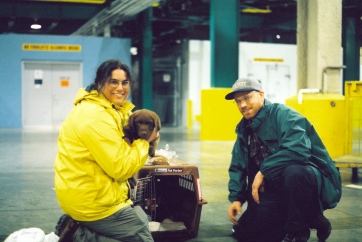
Adolescents. Adolescent dogs are slightly older than puppies. Adolescence starts when the adult teeth are mostly in and can last almost forever! Generally, though adolescence can start as early as 12 weeks and can last until your young dog is between one and two. It is hard to determine exactly when it starts and stops just as it is difficult to tell in humans, so we usually use behaviour to tell when this is going on. Like human adolescents, you will notice irritability, impulsivity, frustration, extreme confidence, extreme fear and lots of learning! Often the learning we see in adolescent dogs includes learning things like how to avoid being caught, how to get into the fridge to steal the cheese and how to avoid bath time. It is important at this age to carefully teach our dogs that they should come when called, stay when told and walk nicely on a leash. If you are seeing fear behaviours, you cannot socialize your way through these any longer because your dog is now past the age where socialization can occur. During adolescence you may need to engage in some remedial socialization through desensitization and counter conditioning. Exercise is something that adolescent dogs need but you have to watch for fatigue because they are still growing.
I well remember Eco, my black German Shepherd when he just started to hit adolescence. He was about thirteen weeks old when we saw the first signs of independence coming along and he decided that anything the big kids could do he could do too. One morning as all the dogs were jumping into the truck, he charged up, and paused. The truck was too high for him to jump but he was determined, so he reared himself up and tried and slammed against the running board. He was REALLY sure he could do it and about two weeks later he was right. As an adolescent, he had many great adventures that reflected his determination, his drive and his certainty that he was right and could do anything that any of the older dogs could do, only better, faster and stronger! This can do attitude stood us in good stead as we started protection work, tracking and obedience work and at the end of adolescence, he titled in obedience because we were able to channel his exuberance into focus and work.
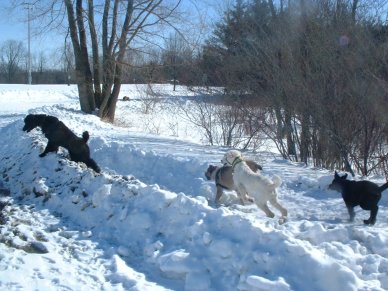
Young adulthood. Dogs are young adults between the ages of about 7 months (more or less, depending on breed!) and 4 years. Once again, the age at which a dog becomes a young adult is a little spongy, just as it is for humans. Four is about the time that most dogs hit social maturity, which in humans is equivalent to between 25 and 30. This is the age when most adult humans realize the importance of things like voting and participating in community development. We are mostly past the early setting up of our lives, and we have the mental resources for this. So until that happens, we are capable, fit and useful young adults who can do amazing physical things and learn the basics of our careers. Until social maturity, dogs are much the same. Most young adult dogs are extremely trainable, especially if they have had a good foundation in puppyhood and adolescence. They are mostly very willing participants in the training process. For working dogs, they are in the early stages of their careers; they still have some polish to gain, but they can perform the work they will be doing and usually they can perform it really well. Generally young adult dogs need a fair amount of exercise and depending on your dog’s breed you should plan on spending 45 minutes to an hour providing that.
As a young adult, D’fer began working as my service dog. He wasn’t perfect and I remember being interviewed once by a newspaper when he was having a young dog moment. He needed a little extra work and reminder that when he was in harness he should not bolt forward and bounce up or down the stairs. I remember the reporter being quite surprised that I was stopping every three stairs to remind him to stay right beside me and to treat him when he got the right answer. Deef was truly a young dog at the time and although he knew his job, he lacked finesse and polish.
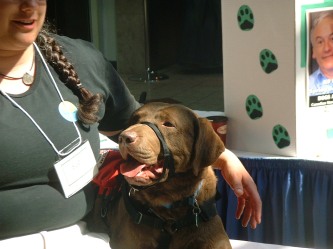
Adulthood. Dogs are adults from about 1 until between 5 and 8 when they hit middle age. This time frame corresponds to the human ages of 18 to about 45. There are still a lot of developmental stages that occur during this time frame, but in general you can see the dog’s personality stabilize and you can expect that he will be fairly consistent in his behaviour though out this time frame. They should not be having accidents in the house, they should not be chewing items up, they should know the rules and for the most part they should follow those rules. They DO need exercise, but now if you skip a day it should not be a tragedy.
As an adult, Friday began to accompany John on his remote backpacking trips into Algonquin park. She was fit, healthy and able to keep up to John as well as to carry her own pack. She never chewed things up such as tents, packs, sleeping bags or gear. She is a good companion for John and she has joined him on every remote backpacking adventure for the past five years or so. She is also versatile and has earned titles in obedience with John. She has taken countless workshops trying out a variety of sports such as frisbee, musical freestyle, tricks and tracking. Adult dogs are go there and do that creatures who make our lives much more interesting just by doing things with us.
Middle age. Middle age could also be considered the golden age for most dogs. In dogs this can begin as early as 5 or 6 and last until as late as 13 or 14 or even older for a small breed dog. Usually, dogs don’t need regular training but they still enjoy it. Usually they don’t need quite as much exercise, but they can still tolerate it. Usually they know the rules and they haven’t yet forgotten them, however they may have become savvy about which rules have exceptions. I think I may love middle age more than any other age, except for those moments when the wind starts to blow at the door, and I start to realize that we may be coming to the end of an era. Just like with people, middle aged dogs often get the “creaks and aches”. You may see arthritis start to appear. Vision may not be as good as it used to be. Your dog may be a little less eager and a little less willing to do the things you used to do together. And you may realize that you know and love one another in a way that you have never known or loved another being before. Middle age truly is the golden age for me when it comes to my dogs.
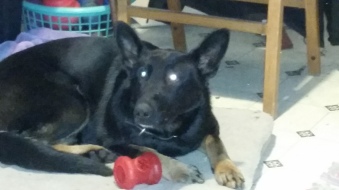
John’s dog Friday is now in middle age. She is still able to go on remote backcountry trips but she is not as active as she used to be. She has survived cancer so we keep an eye on her health a little more closely than we did when she was a younger adult. We know that she is more susceptible to injuries too so John is careful to do lots of warm up with her before asking her to do really active things. On the plus side, she is really willing to meditate with him every day and as an adolescent or young adult she probably would not have thought that was a good idea!
Old age. In giant breeds of dog such as the Great Dane, old age could begin as early as 7, and in tiny breeds such as miniature poodles, it may not arrive until the dog is into his teens. Old age for dogs is an individual thing. Some old dogs are active right up to the end. Some dogs start to slow down sooner rather than later. Every dog is different! In old age, you may see a few behaviours that are reminiscent of puppyhood. Your older dog may start waking up at night. He may break housetraining. He may also forget his skills training. Dogs get a form of dementia called Cognitive Dysfunction, or Canine Cognitive Dysfunction. There are medications that can help, but just like with humans, dogs who are affected are often confused and don’t remember breakfast even though they may remember that one special place every time you drive past it. I think with our senior dogs it is really important to take every day as it comes and do what our old friends feel up to doing. I have had some incredible adventures with my very elderly dogs, but I have also had some serious frustrations!
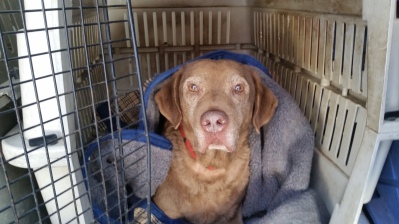
One of my favourite memories of Buddy, my second German Shepherd happened about three months before he died. His bed had been under a picture window in our bedroom for many years, because it was cooler there in the summer and he had a thick coat so he didn’t mind in the winter either. As he aged, he started to feel the cold though, so one morning I tore apart the bedroom so that I could move his bed. He lay outside in the sunshine snoozing while I did this, and when I was done, I called him in. He walked into the bedroom and ambled over to where his bed used to be and stopped dead. If a dog could look appalled, Buddy did! And then he looked sad and confused. I gently showed him where I had moved the bed to, and he brightened right up and then he looked confused again. He looked at the bed. He looked at where the bed had been. Then he looked at his bed again. Then he looked back and he started to pant in a very stressy manner. He started to pace. And I decided that some of the time, old dogs know best, so I put him back outside and put his bed back where it belonged.
Enjoy every age with your dog, but understand that how you talk about your dog’s age does inform your expectations. When you label your adolescent or young adult dog as a puppy be careful that you are not setting up an expectation that he is not capable of doing things that he is able to do.
